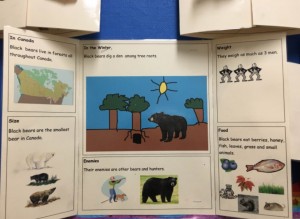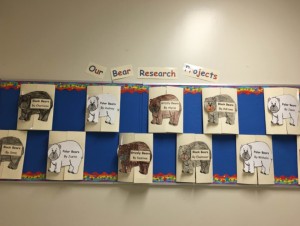There are three grade 1 classrooms in our school. At the beginning of each unit and throughout the unit, we meet to exchange ideas, resources and materials. This ensures that our units don’t become static. We are making changes and adding something new and interesting each year.
We recently completed a unit on Canadian Bears. The children worked in groups and came up with questions about bears and what they wanted to learn. We also frontloaded a few questions of our own that may have been missed. The children listened to informational books about bears and read their own books looking for answers to their questions.
We found some short You Tube videos of bears in their natural habitat so that the children could see what a grizzly bear, black bear and polar bear’s den looked like and where they built it. The children had an opportunity to roleplay and pretend they were a bear building a den and hibernating. We watched short You Tube videos of actual wild bears looking for food and learned how climate change affects their ability to find food. Again groups of children had an opportunity to roleplay being a bear and looking for food, while the rest of the class had to guess what type of bear they were depicting. We printed pictures of the different types of food bears eat and had the children sort the food using a Venn diagram. This year, one of our colleagues borrowed an actual bear fur pelt from the Living Prairie Museum and each class had an opportunity to examine it up close. Once most of our research was complete, and the children had their information recorded on their rough copy sheets, they transferred this information onto a publisher template on computers. They typed their information, drew their bear’s habitat and added the clip art to support their writing. The children printed their work and created folders from their projects. See photos below.


I don’t think our unit on bears would be as interesting and dynamic for the children, if it weren’t for how well all three classrooms collaborated with each other. When everyone is working together to share ideas and support one another great things are achieved.
Francesca Bova
Meadows West School
Cluster Group 1871